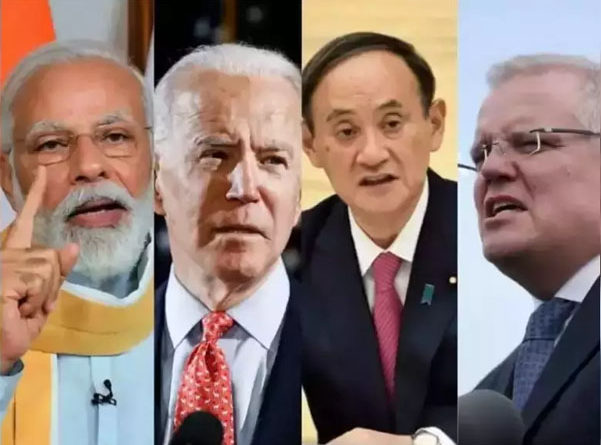Navies Of The ‘Quad’ Can Swing Together To Tackle Any Threat In Indo-Pacific – Top Indian & US Commanders
Apr 14, 2021
PM Modi, US President Biden, Australia PM Morrison and Japan PM Suga, leaders of the four Quad nations.
NEW DELHI: Top Indian and American military commanders on Wednesday said navies of the “Quad” countries could seamlessly swing into action for a joint military operation if the need arises to tackle a threat and ensure a free, open and inclusive Indo-Pacific.
The messaging about the Quad grouping of India, the US, Japan and Australia against a belligerent and expansionist China in the Indo-Pacific was clear. It also came a day after the Chinese official media gleefully latched onto the recent passage by a US warship through India’s EEZ without prior consent to ask New Delhi to re-evaluate its ties with Washington and shed its “illusions”.
The comments of US Indo-Pacific Command chief Admiral Philip Scot Davidson, speaking at the Raisina Dialogue, will surely rile China as he described the Quad as “a diamond of democracies” coming together in the Indo-Pacific, where the “competition is between a closed and authoritarian Beijing vision and the idea of a free and open region”.
Admiral Davidson slammed China for its “aggressive actions and intent” to undermine international laws and norms in the region. Noting that Beijing’s approach includes “efforts to coerce, corrupt and co-opt” governments, businesses, organizations and ultimately the people of the Indo-Pacific, he said, “China is the greatest strategic threat to the rules-based international order”.
Navy chief Admiral Karambir Singh, in turn, said the naval forces of the four Quad nations “already enjoyed a high degree of interoperability” achieved through a series of bilateral and multilateral exercises over the years.
“If an opportunity arises, we have the capability and capacity to operate together in a `plug-and-play’ manner,” said Admiral Singh, noting that the Quad was “evolving and growing organically”.
The top officers noted that China was engaged in a major aircraft carrier-building programme, with two already operational and a third on the way. Admiral Singh said China has the “wherewithal and intent” to continue building a larger navy, especially since its energy sources and markets were located to the west.
“We have seen regular Chinese Navy presence in the Indian Ocean Region (IOR) for over a decade now. As they say, the flag follows the trade. They want to replicate US Navy carrier battle groups but developing the carrier air wing takes time. But they are moving quickly,” he said.
With an overall force of around 350 warships and submarines, including over 130 “major surface combatants”, China has overtaken even the US Navy’s force-level of 293 warships, as was reported by TOI earlier.
The US Navy, of course, is much more technologically advanced, with as many as 11 “super” 100,000-tonne aircraft carriers, each of which can carry 80-90 fighters. At present, India has only one carrier in the shape of INS Vikramaditya. The second, to be christened INS Vikrant, will be delivered by this November but will
become fully operational after “flight trials” by 2023.
Admiral Davidson said the “coming together” in the multilateral format of the Quad “sends a powerful signal” in support of a rules-based international order. “India is a partner with whom we share common values, and strong India-US ties are important for the Indo-Pacific,” he said.
Admiral Singh, on his part, underlined the Indian Navy was ready to do its bit to contribute to the security and stability of the Indo-Pacific, the sheer expanse of which required nations to work together since threats in the maritime domain were “transnational” in nature.
“Each navy brings table, through which collective maritime competence can be built up. In the IOR, the Indian Navy aims to be the preferred security partner,” he said.
“Oceans connect, not divide. Opportunities for cooperation exist. Issue based convergence is possible in the Indo-Pacific, and this convergence can lead to cohesion,” he added.
Courtesy: TOI

